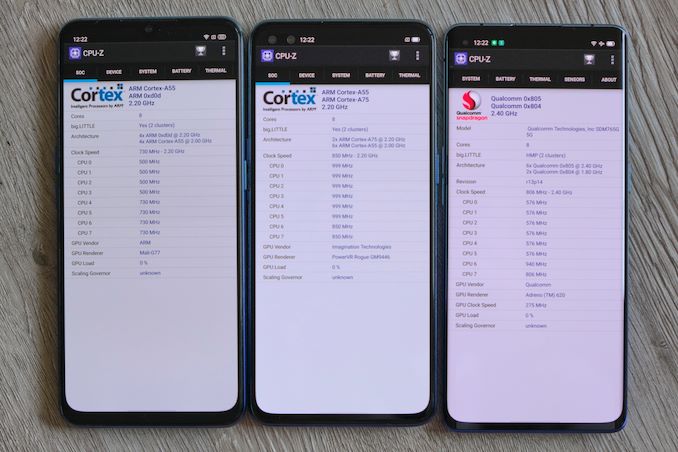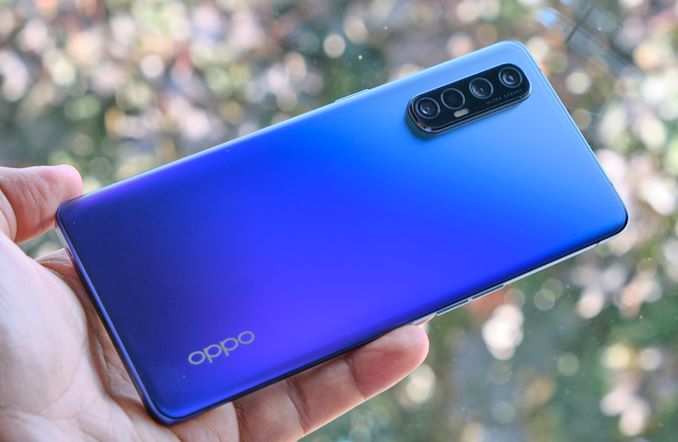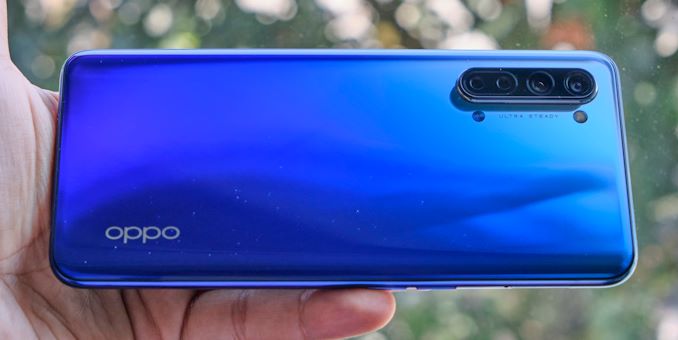OPPO's Reno3 5G vs Reno3 Pro vs Reno3 Pro 5G: Why Don't We See More MediaTek Dimensity 1000 Phones?
by Andrei Frumusanu on August 10, 2020 10:00 AM EST
The last 2 years have been quite exciting for the mobile silicon landscape – Arm’s release of the Cortex-A76 had marked a big jump in performance for smartphones, vastly raising the bar of what is possible to achieve in a mobile SoC. With this generation, we’ve also seen SoC vendors deploy some increasingly competitive designs that improved upon their predecessors – much to do with the new IP, but also a large part thanks to new 7nm manufacturing technologies.
We’re all too familiar with Qualcomm’s Snapdragon 855 and 865 which power the majority of flagship devices in the market right now. Qualcomm has been steadily improving their execution of the last couple of years ever since the Snapdragon 835, and the new S865 is really a great balance between performance and power efficiency for 2020’s devices. We’ve also seen HiSilicon push out quite competitive products with the Kirin 980 and the 990 – although the future of Huawei’s in-house SoC designs are in grave limbo and run the risk of no longer seeing successors in the future.
Qualcomm’s and HiSilicon’s successes have however come at a cost in the market though – we’re all aware of Samsung’s missteps with their Exynos series, although we do hope things will improve in the comings years, fingers crossed.
The other victim to Qualcomm and Huawei’s success has been MediaTek. The Taiwanese SoC vendor had been traditionally been a larger player in the smartphone market, however it’s been losing market share to Qualcomm quarter after quarter for years now. Last year, the company had revealed that with the new 5G generation of “Dimensity” SoCs we’d be seeing a renewed push into the high-end market.
Today, we’ll be taking a closer look at one of these Dimensity 1000 powered phones, the OPPO Reno3 5G. The Reno3 series has been quite the oddball device line-up this year, as the company has been selectively releasing quite different variants at a rapid pace in different markets – all with different SoCs and slightly differing device specs.
| Some OPPO Reno3's | |||
| Reno3 5G (China only) |
Reno3 Pro (Global variant) |
Reno3 Pro 5G a.k.a Find X2 Neo |
|
| SoC | Dimensity 1000L 4x Cortex A77 @ 2.2GHz 4x Cortex A55 @ 2.0GHz Mali-G77MP7 @ 695 MHz |
Helio P95 2x Cortex A75 @ 2.2GHz 6x Cortex A55 @ 2.0GHz PowerVR GM 9446 @ 970MHz |
Snapdragon 765G 1x Cortex A76 @ 2.4GHz 1x Cortex-A76 @ 2.2GHz 6x Cortex-A55 @ 1.8GHz Adreno 620 |
| Display | 6.4-inch OLED 2400 x 1080 (20:9) |
6.4-inch OLED 2400 x 1080 (20:9) |
6.5-inch OLED 2400 x 1080 (20:9) 90Hz |
| Dimensions | 160.3 x 74.3 x 8 mm 181 grams |
158.8 x 73.4 x 8.1mm 175 grams |
159.4 x 72.4 x 7.7 mm 171 grams |
| RAM | 8/12GB LPDDR4X | 8GB LPDDR4 | 8/12GB LPDDR4X |
| NAND Storage |
128GB UFS 2.1 | 128/256GB | 128/256GB UFS 2.1 |
| Battery | 4025mAh (15.57Wh) typ. 3935mAh (15.22Wh) rated |
||
| VOOC Flash Charge 4.0 30W |
|||
| Front Camera | 32MP f/2.0 | 44MP f/2.4 + 2MP f/2.4 |
32MP f/2.0 |
| Primary Rear Camera | 64MP IMX686 1/1.73" 0.8µm f/1.8 w/ OIS |
48MP IMX586 1/2.0" 0.8µm f/1.7 w/OIS |
|
| Secondary Rear Camera |
8MP 1.4µm f/2.25 119° Ultra-wide |
||
| Tertiary Rear Camera |
2MP depth portrait f/2.4 |
13MP 1/3.4" 1.0µm Telephoto |
|
| Extra Camera |
2MP black & white portrait f/2.4 |
2MP black & white portrait f/2.4 |
2MP black & white portrait f/2.4 |
| 4G / 5G Modem |
5G Sub-6 Integrated | 4G LTE | 5G Sub-6 Integrated |
| SIM Size | Dual nanoSIM | ||
| Wireless | 802.11a/b/g/n/ac/ax 2x2 MU-MIMO, BT 5.0 LE, NFC, GPS/Glonass/Galileo/BDS |
802.11a/b/g/n/ac 2x2 MU-MIMO, BT 5.0 LE, NFC, GPS/Glonass/Galileo/BDS |
802.11a/b/g/n/ac/ax 2x2 MU-MIMO, BT 5.0 LE, NFC, GPS/Glonass/Galileo/BDS |
| Connectivity | USB Type-C 3.5mm headset |
USB Type-C | |
| Special Features | In-screen fingerprint sensor | ||
| Launch OS | Android 10 | ||
All in all – there’s 4 different variants of the “Reno3”, with the key characteristic being that we’re seeing quite different devices in the Chinese market compared to the international counterparts. We have had our hands on 3 of these for several months now:
The Chinese market Reno3 5G is the most interesting device today as it’s the one phone that employs MediaTek’s newest Dimensity 1000 SoC. To be precise, this is a “1000L” lower-binned variant of the chip that slightly differs in clocks speeds and GPU configuration. Originally planned for 4x 2.6GHz Cortex-A77 cores with 4x 2.0GHz Cortex-A55 cores and a Mali-G77MP9 at 800+MHz, the new lower-binned chip only clocks the big cores at 2.2GHz, and disables two GPU cores to make it an MP7 configuration at 695MHz. Strangely enough, this May we saw MediaTek re-release the chip in the form of the Dimensity 1000+ with the full specifications that were originally promised late last year.
The Chinese market also received the Reno3 Pro 5G – a higher-end variant of the phone with a different design, powered by Qualcomm’s Snapdragon 765G SoC. This product positioning was quite weird, as on paper, you’d expect the regular Reno3 5G actually outperform the Pro 5G variant – and this is actually the most interesting topic we’ll be addressing today. The Snapdragon 765 features older Cortex-A76 cores, one at 2.4GHz, and one at 2.2GHz, alongside 6x Cortex-A55’s at 1.8GHz, and has the Adreno 620 as its GPU.
The interesting thing also about the Reno3 Pro 5G is that a few months after the Chinese launch, we’ve actually seen the device come to international markets, but this time marketed as the Find X2 Neo.
The Reno3 and Reno3 Pro in international markets are seemingly quite shadows of their Chinese counterparts. The Reno3 comes with a 2018 launched MediaTek P90 chipset, while the Reno3 Pro using a P95 that doesn’t really change much at all in the configuration of the chip beyond a slight clock boost to its AI engine. The 2x Cortex-A75 cores at 2.2GHz with 6x A55’s at 2.0GHz and an ImgTech PowerVR GM 9446 GPU at 970MHz are all quite outdated in 2020 – with the SoC being fabricated on an older 12nm process.
The Reno3 Pro also has very little to do with the Reno3 Pro 5G other than their naming – the latter is clearly a higher-end device in terms of design and screen.
The piece today isn’t much of a device review as it’s more focused on the SoC differences between the phones, with an emphasis on the MediaTek Dimensity 1000L on the Chinese Reno3 5G.
The Reno3 phones are actually outdated by this point in time as the company has followed up with the Reno4 series in China – a slight design iteration on the previous gen, mixing and mashing specifications again whilst retaining the Snapdragon 765G and dropping MediaTek as a SoC source, making today’s article all the more intriguing.












44 Comments
View All Comments
Fritzkier - Thursday, August 13, 2020 - link
Realme X was already discontinued since months ago.Realme releases phones like someone with diarrhea, and only produce it for 6 months at most. Even here, where Realme ranks 4th of smartphone market share, Realme X is nowhere to found.
PeachNCream - Tuesday, August 11, 2020 - link
It would be nice to see more non-Qualcomm phone SoCs out there. In particular just because of the recent Qualcomm DSP vulnerabilities that may never get patched on poorly or not updated phones. Qualcomm has released fixes, but we know all too well how bad things are in a world of disposable handsets.https://www.computerweekly.com/news/252487274/Qual...
Other SoC options may somewhat help prevent these from getting too widespread. Then again, some form of better update deployment would help a lot more and I'm not sure that will ever happen because it probably needs to be done by Google and be baked into Android rather than the fragmented manner its left in now and that has all sorts of implications plus logistical considerations akin to and potentially worse than those that Microsoft faces with PC patches.
TheinsanegamerN - Tuesday, August 11, 2020 - link
You REALLY think that a chinese mediatek chip is going to be more secure then a qualcomm chip? How many vulnerabilities on Mediatek chips have either not been disclosed or never found in the first place because they dont care about older chips?Android security is also not the big scary monster man people make it out to be. Android is relatively locked down in terms of installing software compared to a PC. 99% of android problems are misbehaving facebook installations or people not understanding how to empty their storage correctly.
PeachNCream - Tuesday, August 11, 2020 - link
Sorry, I'm not getting into the anti China racism rhetoric with you. We see enough of that from Duck Trampoline's press briefings.Fritzkier - Thursday, August 13, 2020 - link
He mention that Mediatek are Chinese. Apparently he don't know the difference between Taiwan and Mainland China.NitinYadav251096 - Tuesday, August 11, 2020 - link
I agree with you. But it's time now to bring the MediaTek 5G chipsets in the Indian market and they can do quite well.TheinsanegamerN - Tuesday, August 11, 2020 - link
"Why dont we see more Mediatek"? Well two reasons.1.) Mediatek phones do not support CDMA, so they are a no go in the USA.
2.) Mediatek has a well earned reputation for producing some unspeakably horiffic chipsets. 'unable to run correctly at stock speeds' level terrible. Most brands tend to avoid cheap garbage. Even if Mediatek has straightened out their designs, it will take years before companies trust them enough to use their chips in any halfway expensive phones.
Andrei Frumusanu - Tuesday, August 11, 2020 - link
1) They support CDMA and have had for years.https://www.mediatek.com/news-events/press-release...
https://www.mediatek.com/news-events/press-release...
2) I haven't seen evidence of this. The only times they had issues is when everybody else had issues as well (20nm, so on).
patel21 - Tuesday, August 11, 2020 - link
Combination of Huawei Phones with Mediatek Chipsets is indeed a Synergetic relationship that could give Qualcomm the competition it needs by making Mediatek relevant again.Quantumz0d - Tuesday, August 11, 2020 - link
GNU GPL v2 violator, these phones do not get proper updates and use that Chinese OSes on top. OnePlus had a breach again in 2020 for loss of customer data. Cannot run a Custom ROM on these devices.This MediaTek is trash since start and It has to stay like that unless they open up.